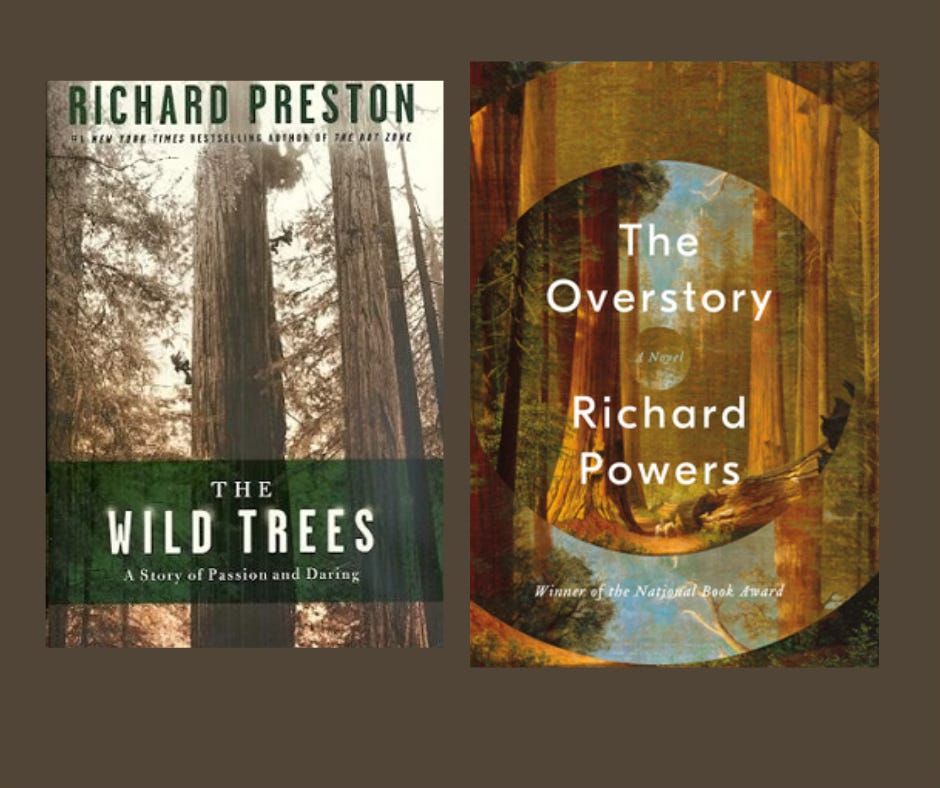People feel uplifted walking among redwoods, not dwarfed or diminished.
Like gods of the earth, they bring us to awe.
A fire or a windstorm can harm them, but great vulnerability is not their nature. Redwood bark is a shield—it grows up to a foot thick, rich with water and tannins to withstand all but the worst fires.
Coast redwoods (sequoia sempervirens) grow in the foggy regions of Northern California; giant sequoias (sequoia giganteum), heavier by girth and volume, grow on the western slopes of the Sierra Nevada. Both species form redwood “cathedrals,” a circle of trees that invite humans into their filtered light and draw the eye up. Sprouting from the roots of a damaged or fallen one and sustained by the parent’s roots, they rapidly head for the sky. As the parent tree’s trunk breaks down, the center disappears and a ring of redwoods is left. Step inside and you know why they’re called cathedrals.
Even hollowed out by fire, a redwood continues to grow. The terrible 2020 Lightning Complex fire near Santa Cruz burned 97% of redwoods in Big Basin state park, yet four years later some are already over twenty feet tall, re-sprouted from the base, limbs or trunk.
These extraordinary trees are at risk now. Years of drought have stressed them, slowed their growth. Too many dry hot days, and they suffer.
Roughly a fifth of mature giant sequoias have been killed by wildfire in the past few years. Trees that easily survive two millennia have been devastated by human activity. In the 1800s and 1900s loggers sailed up the California coast to locate the tallest ones, then came ashore to hack them down. Only five percent of old growth redwoods still exist, a few near me in Oakland, and I have walked many miles among them.
Time has a different quality in a forest, a different kind of flow. Time moves in circles, and events are linked, even if it's not obvious that they are linked. These words are from The Wild Trees by Richard Preston, a book about people who climb and study the giants in Humboldt County on the north coast.
An amazing read, the author conceals the location of the trees he explores, not to tempt us. Climbing a redwood is a perilous and exhilarating project.
What lives in the crown of the Atlas Grove in Humboldt is almost unbelievable: tiny aquatic creatures, crustaceans, shrimp-like, barely visible. Other species of trees sprout, as well as berry bushes and ferns. Voles and salamanders make a home in the sky up there. Conversations take place between crowns far above us and roots below.
The word tree is related to the English word ‘true’. In Old English, ‘tree’ was ‘treow’, which not only meant tree but also ‘trust’ or ‘promise’.
The awe that trees engender flows from their uprightness, their reach for sky, sun, wind.
We also call people who are honest, who have integrity, upright. Breaking my hip in late August gave me true appreciation for uprightness. Erect posture, rare in the animal kingdom, is a singular human achievement.
Trees lack our mobility, but their rootedness allows its own graceful motion. Once I sat in a meditation hall watching trees on a hillside sway in a strong wind—dramatically, kinetically, responsive to each others’ movement. Each tree had its motion, similar but different, depending on size, number and pattern of branches, leaf shape, an intricate choreography my eye could barely track. Art without artifice.
Richard Powers’ The Overstory centers on the diversity, talents, and vulnerabilities of trees. He too is in awe of sequoias: The redwoods knock all words out of them. Nick drives in silence….It’s not the size that throws him, or not just the size. It’s the grooved, Doric perfection of the red-brown columns, shooting upward from the shoulder-high ferns and moss-swarmed floor—straight up, with no taper, like a russet, leathery apotheosis. And when the columns do start to crown, it happens so high, so removed from the pillars’ base, that it might as well be a second world up there, up nearer eternity.
We depend on trees for food, shelter, clothing and oxygen. Forests are refuges in times of crisis. Fugitives, fleeing slaves, the persecuted and the hunted have survived there, including Jews in WW2 Europe. Anne Michaels’ Fugitive Pieces is in part the story of a boy, Jakob Beer, who escaped the massacre of his family and hid in the woods until he was finally rescued.
The forest vs. the tree is a problematic idiom. Singularity within multiplicity confuses us when it should intrigue us, insist we hold them together, a capacity humans do not excel at. One usually loses the big picture or the individual.
Their inseparability is the point. Even when a single tree has been isolated. Trees along city streets struggle harder for existence, cut off from their community, isolated from their own and other species whose roots would send nutrients, warnings, and care when they are ill. Turns out that trees are social beings too.
How much of human trouble arises from not seeing the forest and the trees as coexistent?
Beverly Burch’s most recent book is the novel, What You Don’t Know. She has also published four poetry collections and two nonfiction books. Her work won the John Ciardi Prize, a Lambda Literary Award, and a Gival Poetry Prize and was a finalist for Audre Lorde Award. She lives in Oakland, CA. Website: www.beverlyburch.com
Purchase WHAT YOU DON’T KNOW here.





I loved reading this Beverly! We have two giant redwoods on our property that bless us every day. Being laid up myself this past month I yearn to get back to hiking in the forest again. Reading this made me feel like I was almost there
I waited until I had time to read this, and I’m glad I did. Thank you.